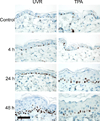The skinny on Slug
- PMID: 20721976
- PMCID: PMC3632330
- DOI: 10.1002/mc.20674
The skinny on Slug
Abstract
The zinc finger transcription factor Slug (Snai2) serves a wide variety of functions in the epidermis, with roles in skin development, hair growth, wound healing, skin cancer, and sunburn. Slug is expressed in basal keratinocytes and hair follicles where it is important in maintaining epidermal homeostasis. Slug also helps coordinate the skin response to exogenous stimuli. Slug is rapidly induced by a variety of growth factors and injurious agents and Slug controls, directly or indirectly, a variety of keratinocyte responses, including changes in differentiation, adhesion, motility, and production of inflammatory mediators. Slug thus modulates the interactions of the keratinocyte with its environment and with surrounding cells. The function of Slug in the epidermis appears to be distinct from that of the closely related Snail transcription factor.
© 2010 Wiley-Liss, Inc.
Figures






Similar articles
-
Microarray analysis demonstrates a role for Slug in epidermal homeostasis.J Invest Dermatol. 2008 Feb;128(2):361-9. doi: 10.1038/sj.jid.5700990. Epub 2007 Jul 19. J Invest Dermatol. 2008. PMID: 17637818
-
Ultraviolet radiation stimulates expression of Snail family transcription factors in keratinocytes.Mol Carcinog. 2007 Apr;46(4):257-68. doi: 10.1002/mc.20257. Mol Carcinog. 2007. PMID: 17295233
-
Cutaneous wound reepithelialization is compromised in mice lacking functional Slug (Snai2).J Dermatol Sci. 2009 Oct;56(1):19-26. doi: 10.1016/j.jdermsci.2009.06.009. Epub 2009 Jul 29. J Dermatol Sci. 2009. PMID: 19643582 Free PMC article.
-
Epidermal cytokines and their roles in cutaneous wound healing.Br J Dermatol. 1991 Jun;124(6):513-8. doi: 10.1111/j.1365-2133.1991.tb04942.x. Br J Dermatol. 1991. PMID: 2064935 Review.
-
Dynamic life of a skin keratinocyte: an intimate tryst with the master regulator p63.Indian J Exp Biol. 2011 Oct;49(10):721-31. Indian J Exp Biol. 2011. PMID: 22013738 Review.
Cited by
-
FBXO11 promotes ubiquitination of the Snail family of transcription factors in cancer progression and epidermal development.Cancer Lett. 2015 Jun 28;362(1):70-82. doi: 10.1016/j.canlet.2015.03.037. Epub 2015 Mar 28. Cancer Lett. 2015. PMID: 25827072 Free PMC article.
-
Slug expression during melanoma progression.Am J Pathol. 2012 Jun;180(6):2479-89. doi: 10.1016/j.ajpath.2012.02.014. Epub 2012 Apr 13. Am J Pathol. 2012. PMID: 22503751 Free PMC article.
-
LepRb+ cell-specific deletion of Slug mitigates obesity and nonalcoholic fatty liver disease in mice.J Clin Invest. 2023 Feb 15;133(4):e156722. doi: 10.1172/JCI156722. J Clin Invest. 2023. PMID: 36512408 Free PMC article.
-
Slug (SNAI2) expression in oral SCC cells results in altered cell-cell adhesion and increased motility.Cell Adh Migr. 2011 Jul-Aug;5(4):315-22. doi: 10.4161/cam.5.4.17040. Epub 2011 Jul 1. Cell Adh Migr. 2011. PMID: 21785273 Free PMC article.
-
A Theoretical Model of the Wnt Signaling Pathway in the Epithelial Mesenchymal Transition.Theor Biol Med Model. 2017 Oct 10;14(1):19. doi: 10.1186/s12976-017-0064-7. Theor Biol Med Model. 2017. PMID: 28992816 Free PMC article.
References
-
- Barrallo-Gimeno A, Nieto MA. The Snail genes as inducers of cell movement and survival: implications in development and cancer. Development. 2005;132(14):3151–3161. - PubMed
-
- Barrallo-Gimeno A, Nieto MA. Evolutionary history of the Snail/Scratch superfamily. Trends Genet. 2009;25(6):248–252. - PubMed
-
- Nieto MA. The snail superfamily of zinc-finger transcription factors. Nat Rev Mol Cell Biol. 2002;3(3):155–166. - PubMed
-
- Hay ED. An overview of epithelio-mesenchymal transformation. Acta Anat (Basel) 1995;154(1):8–20. - PubMed
Publication types
MeSH terms
Substances
Grants and funding
LinkOut - more resources
Full Text Sources
Research Materials

